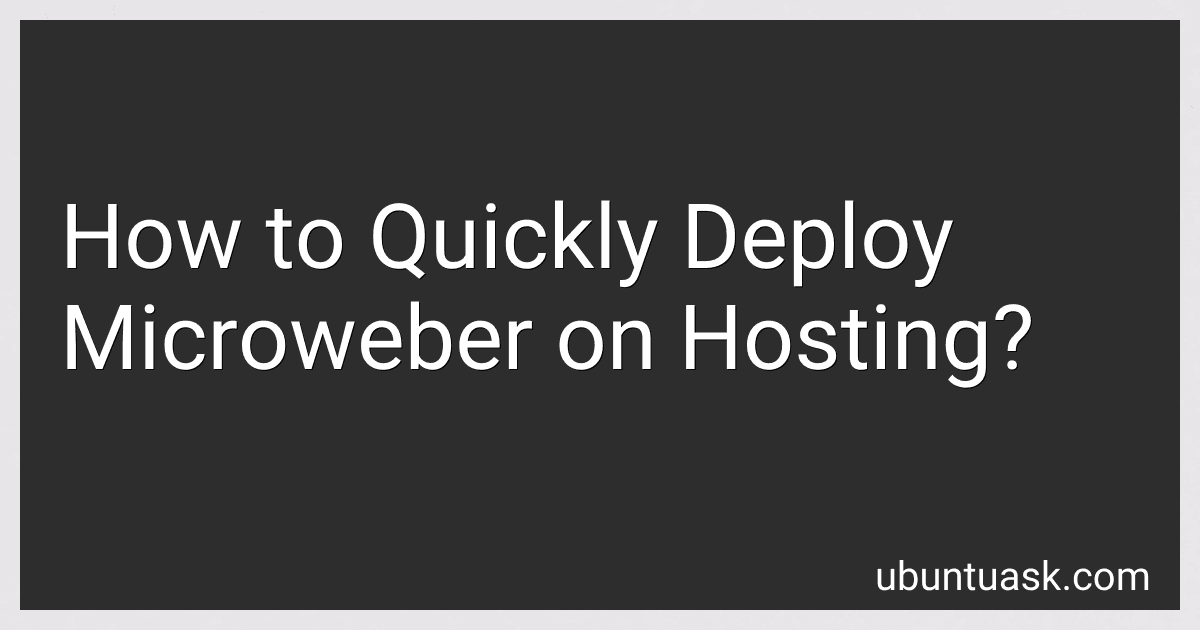Best Web Hosting Tools to Buy in January 2026

How To Create A Website Using Wordpress: The Beginner's Blueprint for Building a Professional Website in Less Than 60 Minutes



Building Tools with GitHub: Customize Your Workflow



Creating a Website: The Missing Manual



All My Podcast Shit: Funny Podcast Log Book Planner, Hosting Notebook & Podcasting Journal Logbook for Planning Perfect Podcasts - Gift for Podcasters, Hosts, Producers & Entrepreneurs Men & Women



Modern Web Development: A Beginner's Guide to HTML, CSS, Hosting, and SEO



Full Stack Web Development for 2025: The Complete Guide to Modern Web Apps


To quickly deploy Microweber on hosting, you can follow these steps:
- Choose a hosting provider that supports the minimum requirements for Microweber. This includes PHP version 7 or higher, MySQL version 5.0 or higher, and Apache or Nginx web server.
- Obtain the latest version of Microweber from the official website. It's usually available as a downloadable ZIP archive.
- Log in to your hosting account using an FTP client or the hosting provider's file manager.
- Create a new directory in the root folder of your hosting account where you want to install Microweber. You can choose any name for the directory.
- Extract the contents of the Microweber ZIP archive to the newly created directory.
- Create a new MySQL database through your hosting provider's control panel or admin interface. Make sure to note down the database name, username, and password as you will need them during the installation process.
- Open a web browser and enter the URL of your Microweber installation directory. For example, if you installed it in a directory called "microweber" under your domain "example.com", the URL would be "example.com/microweber".
- You will be greeted with the Microweber installation wizard. Select your preferred language and click "Next".
- On the next page, enter the database details including the host, database name, username, and password. Click "Next" to proceed.
- Provide the basic website details such as the website name, administrator email, and password. Optionally, you can choose a template or skip this step to select one later. Click "Next" to continue.
- Microweber will now start installing and configuring the necessary files and database tables. This may take a few minutes.
- Once the installation is complete, you will see a confirmation message. You can then proceed to the admin dashboard by clicking "Login to your website".
That's it! You have successfully deployed Microweber on your hosting. You can now start customizing your website's content, layout, and features through the admin dashboard.
How to set up cron jobs for scheduled tasks in Microweber on hosting?
To set up cron jobs for scheduled tasks in Microweber on hosting, you can follow the steps below:
- Log in to your hosting account's control panel (e.g., cPanel, Plesk, etc.).
- Look for the "Cron Jobs" or "Scheduled Tasks" section. It is usually located under the "Advanced" or "System" category.
- Click on "Cron Jobs" or "Scheduled Tasks" to open the cron job management interface.
- In the cron job management interface, you will see options to add a new cron job. Click on "Add Cron Job" or a similar button.
- In the "Command" or "Command to run" field, enter the command to run the Microweber scheduled task. The command typically follows this format: php /path/to/microweber/artisan schedule:run >> /dev/null 2>&1 Replace "/path/to/microweber" with the actual path to your Microweber installation. If you are unsure about the path, you can usually find it by checking the file structure of your hosting account.
- Choose the desired frequency for the cron job. This can include options like every minute, every hour, every day, etc. Select the appropriate option based on how frequently you want the scheduled task to run.
- Save the cron job by clicking on the "Save" or "Add Cron Job" button. The cron job will now be set up and will run at the specified frequency.
Please note that the steps provided here may vary slightly depending on the hosting control panel you are using. If you are unsure about the exact process, you can consult your hosting provider's documentation or contact their support for assistance.
How to manage user roles and permissions in Microweber on hosting?
To manage user roles and permissions in Microweber on hosting, follow the steps below:
- Log in to your Microweber admin panel.
- Click on the "Users" tab in the sidebar menu.
- On the Users page, you will see a list of all registered users. Click on the user you want to manage roles and permissions for.
- In the User Details page, click on the "Roles" tab.
- Here, you can see the current roles assigned to the user. To add a new role, click on the "Add Role" button.
- In the Add Role popup, you can create a new role or select an existing role to assign to the user. Provide a name for the role and click on the "Save" button.
- Once the role is added, you can manage the permissions for that role. Click on the "Permissions" tab.
- In the Permissions page, you will see a list of available modules, templates, and other settings that you can assign permissions for. Enable or disable the permissions as per your requirements.
- Click on the "Save" button to save the changes.
- The user will now have the assigned role and corresponding permissions.
Note: Make sure you have an administrator role to access and manage user roles and permissions.
What is the recommended file permission setting for a Microweber deployment on hosting?
The recommended file permission setting for a Microweber deployment on hosting is typically 755 for directories and 644 for files.
Directories should have the permission set to 755, which means the owner has read, write, and execute rights, while others have read and execute rights. This allows the owner to create, modify, and access the directory and its contents, while others can only access and execute files within the directory.
Files should have the permission set to 644, which means the owner has read and write rights, while others have only read rights. This allows the owner to modify and access the files, while others can only access and read the files.
These permission settings provide a balance between security and functionality, allowing the necessary access for the Microweber application to function properly while providing some level of protection against unauthorized modifications.
What steps should I follow to deploy Microweber on hosting?
To deploy Microweber on hosting, you can follow these steps:
- Choose a web hosting provider: Look for a web hosting provider that meets the system requirements for Microweber. Ensure that the hosting plan includes PHP and MySQL support.
- Domain and hosting setup: Register a domain name for your website and set up the hosting by following the guidelines provided by your hosting provider.
- Download Microweber: Visit the official Microweber website and download the latest stable release of the CMS.
- Prepare the website files: Extract the downloaded Microweber file on your local computer. Open the extracted folder and locate the files and directories.
- Upload the files: Connect to your hosting account via FTP or use the hosting's file manager and upload the Microweber files to the desired location on your server. This can be the root directory (public_html/www) or a subdirectory.
- Create a MySQL database: Access your hosting control panel and create a new MySQL database. Note down the database name, username, and password.
- Run the installation script: Visit the URL where you uploaded Microweber. You will be prompted with the installation wizard. Follow the on-screen instructions to complete the installation.
- Configure Microweber: During the installation, you will be asked to provide your website details, admin login credentials, and database connection details. Input the required information accurately.
- Complete the installation: After providing the necessary information, the installation script will install Microweber and create the required database tables.
- Remove the installation directory: Once the installation is complete, it is recommended to delete the "install" directory from your server for security reasons.
- Access your Microweber admin dashboard: Visit the URL of your Microweber website followed by "/admin" (e.g., www.example.com/admin). Login using the admin credentials you created during the installation.
You have now successfully deployed Microweber on your hosting. You can start designing and customizing your website using the Microweber admin dashboard.
What are the important security measures to consider for a Microweber deployment on hosting?
When deploying Microweber on a hosting platform, there are several important security measures to consider:
- Keep Microweber Up to Date: Regularly update your Microweber installation to ensure that you have the latest security patches and bug fixes. This will help protect against known vulnerabilities.
- Secure Hosting Environment: Choose a hosting provider with a solid reputation for security. Ensure that the hosting environment is properly configured, including secure file permissions, restricted access, and regular backups.
- Strong Passwords: Use strong and unique passwords for all user accounts, including the administrator account. Avoid using common or easily guessable passwords.
- User Permissions: Assign appropriate user permissions to limit access to sensitive areas of the CMS. Only provide the necessary level of access to each user.
- Firewall and Intrusion Detection: Implement a web application firewall (WAF) to protect against common threats, such as SQL injection and cross-site scripting (XSS) attacks. Consider using an intrusion detection system (IDS) to monitor and block suspicious activity.
- SSL/TLS: Protect data transmitted between the website and its users by implementing an SSL/TLS certificate. This ensures that data is encrypted and cannot be intercepted by attackers.
- Regular Backups: Maintain regular backups of the website's data and files. This will help you restore the website in case of a security breach or data loss.
- Security Plugins/Extensions: Utilize security plugins or extensions provided by Microweber or third-party vendors. These can add an extra layer of security and help detect and block malicious activity.
- Strong File Permissions: Ensure that file permissions are set correctly to prevent unauthorized access and modification of files. Restrict write permissions to only necessary directories.
- Security Monitoring and Auditing: Regularly monitor the website for any security incidents or unusual activity. Use tools to audit the website's security configuration and scan for vulnerabilities.
By following these security measures, you can help protect your Microweber deployment from potential security threats and ensure the safety of your website and user data.
